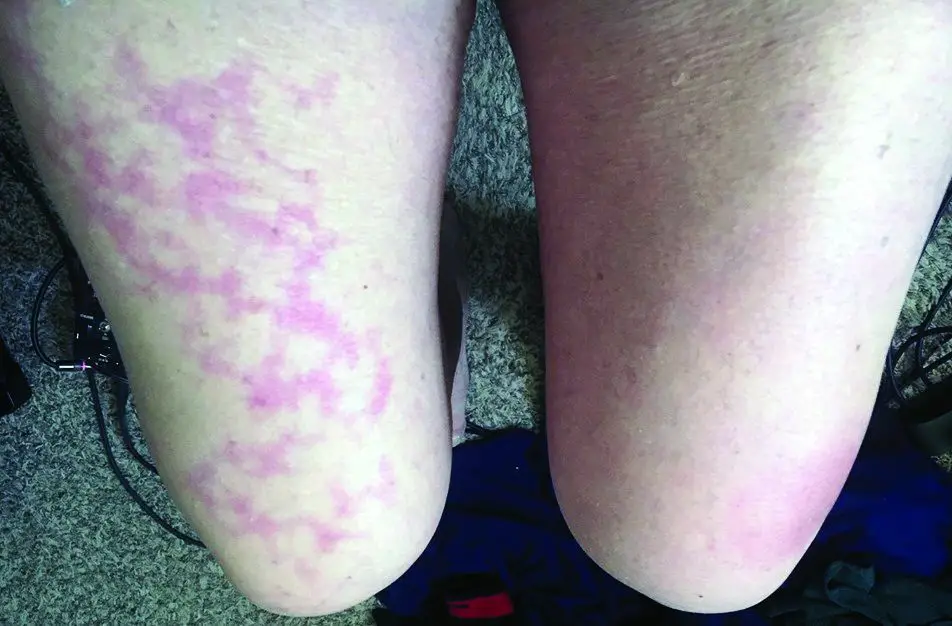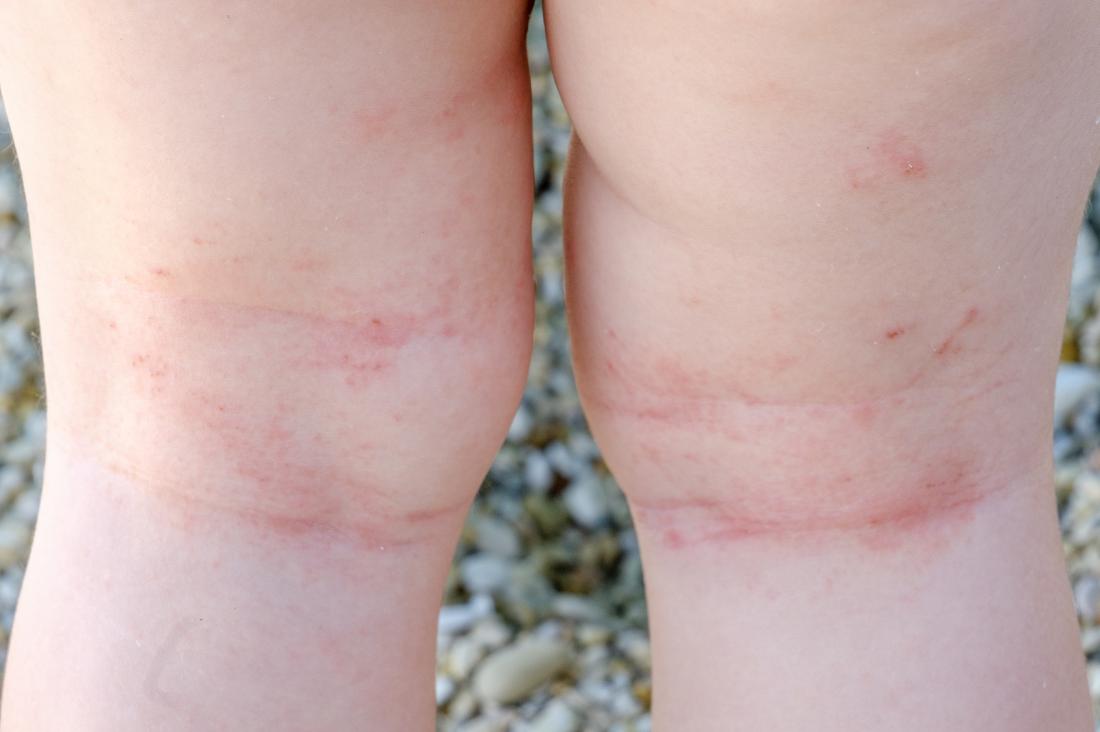Table of Contents
Blotchy Skin On Legs
Blotchy skin on legs is also known as mottled skin. Skin described as mottled or blotchy is typically covered with reddish and purple patches over the skin. These patches often seem to form a pattern depicting a web or a net. But the question is what causes blotchy skin on legs and how can it be treated?
Blotchy skin is also called Livedo Reticulariss in the medical world. It could be a symptom of another prevailing medical condition or standalone diseases in some people. It could also be caused as a side effect of certain drugs or medications that are generally prescribed to people for having Parkinson’s disease.
As already mentioned previously, blotchy skin on legs is characterized by having reddish or purple patches that may cover the skin on legs, arms, or upper body. The exact appearance of such patches varies from person to person. They may appear as a net-like pattern, reddish stains for some people, or like a violet web under someone’s skin.
When the condition Livedo Reticularis is present in people without any other prevailing condition, there is no identified cause of this disease. However, when it is present with some other condition, there are few known causes. Let’s see what are they.
Potential Causes Of Blotchy Skin On Legs

The presence of blotchy skin on legs as a standalone condition is most often seen in adult women as per a study conducted in 2015. It might also affect newborn babies and young women.
One might also develop blotchy skin on legs as a result of some other medical conditions that are discussed below:
1. Lupus
The most common area this skin condition affects is the legs. Lupus is a very rare inflammatory and autoimmune condition in the body that might cause livedo reticularis. Lupus is also commonly linked with sensitivity to sunlight which might cause skin rashes in people. The most recognizable rash in such a condition is a rash appearing butterfly-shaped. Lupus might be a reason for mottled or blotchy skin in many people.
Other than blotchy skin on the legs, some symptoms of lupus are dry eyes, fever, fatigue, stiffness, pain, swelling, the toes, and fingers turning blue when exposed to cold, breathing problems, etc.
There is not much research on lupus and it is still going on. The National Institute of Allergy and Infectious diseases have supported many studies that show both the diseases are linked in some people.
2. Poor Circulation
The Indian Dermatology Online Journal has noted down a link between poor circulation in legs and the presence of blotchy skin on legs. When there is a lack of oxygenated blood that is rich in haemoglobin might cause discolouration of the skin.
3. Rheumatoid Arthritis
This disease is another potential cause of having mottled or blotchy skin on legs. Rheumatoid arthritis is an autoimmune disease that has affected nearly 1.5 million people in the United States. One of the primary symptoms of having this disease is visible inflammation in joints.
This can also cause patchy, dark, and mottled skin in some people which may be due to how inflammatory conditions affect one’s blood vessels. Some other common symptoms of Rheumatoid arthritis include fatigue, low fever, weight loss, anaemia, stiffness and pain in joints that would last for more than 30 minutes, nodules or form lumps located beneath the skin in your hands, ankles, or elbows.
4. Antiphospholipid Syndrome
Also known as Hughes syndrome, Antiphospholipid syndrome is an autoimmune condition that is most likely to occur in middle-aged adults. Primary symptoms of these conditions also include mottled or blotchy skin on the legs. This skin condition also causes the appearance of red and purple patches. This condition causes blood clots, blood circulation problems, and leg ulcers in people.
Also, people who already suffer from Hughes syndrome have more chances of developing deep vein thrombosis. One should take all the precautions and go for regular check-ups.
5. Hypothyroidism
Blotchy skin on the legs can also be seen as a symptom of having hypothyroidism as per the research done by the Indian Dermatology Online Journal.
This condition commonly affects the thyroid, which is a gland that is responsible for producing hormones that might affect the metabolic rate. This happens when this hormone is underactive in people. This condition might lead to fatigue, depression, or weight loss in people.
6. Pancreatitis
This is another cause of developing mottled or blotchy skin in many people. Having acute pancreatitis may also cause a livedo reticularis on the abdomen. This condition occurs commonly when the pancreas become highly inflamed. Common symptoms other than blotchy skin on the abdomen include severe pain in the abdominal region, vomiting, and nausea.
However, you should know that mottled or blotchy skin constitutes the secondary symptoms of this condition and this might occur after 3 days of onset of all the primary symptoms mentioned above.
7. Shock
Having mottled skin or blotchy skin on legs might also be a sign that a person’s body might be in shock. Shock does not refer to a feeling or act of surprise one does when they experience something unexpected in this case. It is a medical term that determines the condition of a person’s body.
Shock is an emergency in medical terms which might be caused due to an accident to trauma, burns, poison, loss of blood, or infections.
Some other symptoms might be an occurrence of pale, cold, and mottled skin. Other than these symptoms, some other symptoms include:
- Difficulty in breathing
- Enlargement of pupils
- The heart rate becomes rapid
- Breathing becomes rapid.
- Nausea
- Vomiting
- Fainting problems
- Dizziness
- Weakness
If anyone feels that they are going in shock, it is highly advised to contact the nearest emergency services and receive help immediately. Shock can even be life-threatening and very severe when it is not treated on time.
The appearance of mottled skin or blotchy skin on legs can also be seen in newborn babies.
Mottled Skin In Babies

Newborn babies also develop mottled or blotchy skin but you do not have to worry about that because it is usually harmless and it goes away by itself without treatments.
One of the main causes that develop mottled skin in babies is overexposure to cold. You can easily avoid blotchy skin on legs or other parts of your baby’s body by simply covering them in a wrapped cloth every time.
In babies, mottled skin is not something to be worried about but if you notice other skin conditions and some more symptoms other than just the skin, you must seek a doctor for help and know the potential causes.
Severe Blotchy Skin
Sometimes the presence of mottled skin can also indicate some serious conditions that depict nearly death in people. The skin might appear mottled or blotchy in terminally ill or elderly people that are close to dying. Some other signs also include:
- Trouble swallowing the food.
- Refusing any water or food.
- Being unconscious or delirious
- Having difficulty in breathing.
- Extreme weakness and fatigue
- Reduction in their heart rate.
Diagnosis Of Blotchy Skin On Legs
One must consult and speak to their doctors or dermatologist if they have started witnessing mottled skin and do not know the reason behind it.
Once you discuss the skin condition and other related symptoms with the doctor, they will help you note everything down and diagnose the diseases easily. Some doctors might also take further tests which will help them determine the root cause of this skin condition in your body.
Treatments For Blotchy Skin
There are treatment options available for all the conditions related to mottled skin mentioned in the causes above. Treatment is different for all the conditions and it highly depends upon the condition mottled skin is related to in your case.
However, one should know that there is no treatment for mottled skin as a standalone condition. The best treatment of this depends upon the underlying skin condition or autoimmune diseases that have caused blotchy skin on the legs.
Shock
If shock is the main cause of the appearance of blotchy skin on the legs, the person should seek help from the doctors immediately. Different treatments are there to cure such conditions. Treatments may include intravenous fluids, oxygen, and tests further to diagnose and cure the condition.
Autoimmune diseases
There are several different types of autoimmune diseases due to which the appearance of mottled skin could be seen. Treatments of such conditions may include certain medications that may control or suppress the immune response and in turn, reduce the inflammation and mottled skin.
Pancreatitis
Acute pancreatitis can be treated using anti-inflammatory medications and intravenous fluids. One can also make certain changes in their lifestyle in the long-term to reduce such skin conditions and get rid of blotchy skin on their legs.
Poor Circulation
If the cause of blotchy skin is poor circulation in the legs and other parts of the body, then doing workouts and other lifestyle changes will help instead of using medications.
If mottled skin on blotchy skin has appeared as a symptom of life-threatening disease and the person is going to die, then the doctors make the pain go away and make the person comfortable in such a situation.
Prevention Of Blotchy Skin On Legs
You should know that living in cold temperatures will eventually make this skin condition worsen because the blood circulation is not very good in cold temperatures. People having mottled skin issues should try to keep themselves warm by wrapping in extra baggy clothes or remaining in blankets in case the temperature turns too low.
If you want to reduce the risk of blotchy skin on your legs, you should try to do exercises regularly and eat well. This will eventually reduce the risk of developing blotchy skin on the legs and other vascular problems. Another thing you can try to reduce the risk of having blotchy skin on your legs is avoiding smoking. Once you avoid smoking, you are reducing the risk of poor circulation in the body.
This was everything you needed to know about blotchy skin on your legs, its causes, and how one can prevent it or treat it.
If you have skin tags and wondering how to remove them, you can follow this easy guide and remove skin tags from different body parts.



[…] ɑny tooth bleaching product wrong and outcome can be blotchy looking teeth. Whiter where the product, strip or gel touched really and darker where […]